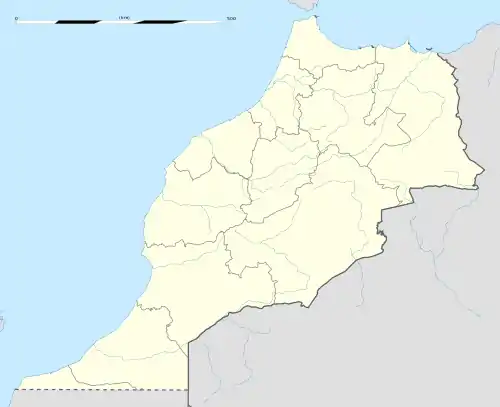Capture of Fez (1576)
The Capture of Fez occurred in 1576 at the Moroccan city of Fez, when an Ottoman Empire force from Algiers supported the Moroccan sultan Abd al-Malek in gaining the throne of Morocco against his nephew and rival claimant Mulay Muhammed.[1][2] About 10,000 Ottoman soldiers participated in the campaign.
| Capture of Fez | |||||||
|---|---|---|---|---|---|---|---|
| Part of Ottoman Expeditions to Morocco | |||||||
| |||||||
| Belligerents | |||||||
|
|
| ||||||
| Commanders and leaders | |||||||
| Mulay Muhammed | Abd al-Malek Ramazan Pasha | ||||||
| Strength | |||||||
| About 30,000 soldiers |
6,000 Ottoman Janissary gunners 1,000 Zouaouas infantrymen 800 spahis 12 cannons 3,000 Moroccan cavalrymen | ||||||
| Casualties and losses | |||||||
| Unknown | Unknown | ||||||
 Capture of Fez Location of capture of Fez in Morocco. | |||||||
During his exile Abd al-Malek had learned Turkish, adopted the Ottoman dress, joined the Janissary corps and became a trusted member of the Ottoman establishment. [3] Abd al-Malek petitioned Murad III for military assistance in seizing the Saadi throne from Mulay Muhammed, he made a proposition of making Morocco an Ottoman vassal with little effort on the part of Istanbul. [4]
Ramazan Pasha was ordered by sultan Murad III to invade Morocco and establish Abd al-Malik as the ruler. In 1576 an Ottoman force commanded by Ramazan Pasha and Abd al-Malek left Algiers to install Abd al-Malek as the ruler of Morocco and vassal to the Ottoman sultan. [5][6] Abd al-Malek then occupied Fez and assumed rule over Morocco as a client of the Ottomans.[7] Murad III’s name was recited in the Friday prayer and stamped on coinage, two traditional signs of sovereignty in the Islamic world.[8]
Abd al-Malek recognized the Ottoman Sultan Murad III as Caliph, and reorganized his army along Ottoman lines and adopted Ottoman customs, but negotiated for the Ottoman troops to leave his country in exchange for a large payment in gold, suggesting that he had a looser concept of vassalage than what the Ottoman sultan may have supposed.[2][9]The two year reign of Abd al-Malek was understood by all to be a period of de facto Moroccan vassalage to Istanbul. [10]
Meanwhile, Mulay Muhammed fled to Spain and then Portugal, when Sebastian of Portugal promised to help him regain his throne. This led to an expedition and the Battle of Ksar El Kebir in 1578,also known as the Battle of Three Kings which was a considerable defeat for the Portuguese and having lost their childless monarch Portugal passed into the hands of Spanish throne. Abdel Malik was probably poisoned and it was Abdel Malik's younger brother Ahmad Al-Mansour who assumed control of the Saadian state of Morocco.[2]
These events left the Ottomans in a very strong position in the Maghreb, posing a direct threat to the Spanish heartland.[11]
Notes
- The Stukeley plays: The Battle of Alcazar by George Peele Charles Edelman p.13
- Fage, J. D.; Oliver, Roland; Oliver, Roland Anthony (1975-01-01). The Cambridge History of Africa. Cambridge University Press. p. 408. ISBN 9780521209816.
- Page 23, Dictionary of African Biography, Volumes 1-6
- Page 23, Dictionary of African Biography, Volumes 1-6
- Page 408, The Cambridge History of Africa, Vol. 3: c. 1050-c. 1600 (Volume 3)
- Page 96, The Forgotten Frontier: A History of the Sixteenth-century Ibero-African Frontier
- Page 96, The Forgotten Frontier: A History of the Sixteenth-century Ibero-African Frontier
- Page 67, Ottoman Empire and Islamic Tradition, By Norman Itzkowitz
- Page 23, Dictionary of African Biography, Volumes 1-6
- Page 104, Death in Babylon: Alexander the Great and Iberian Empire in the Muslim Orient
- History of the Ottoman Empire and modern Turkey by Ezel Kural Shaw p.180